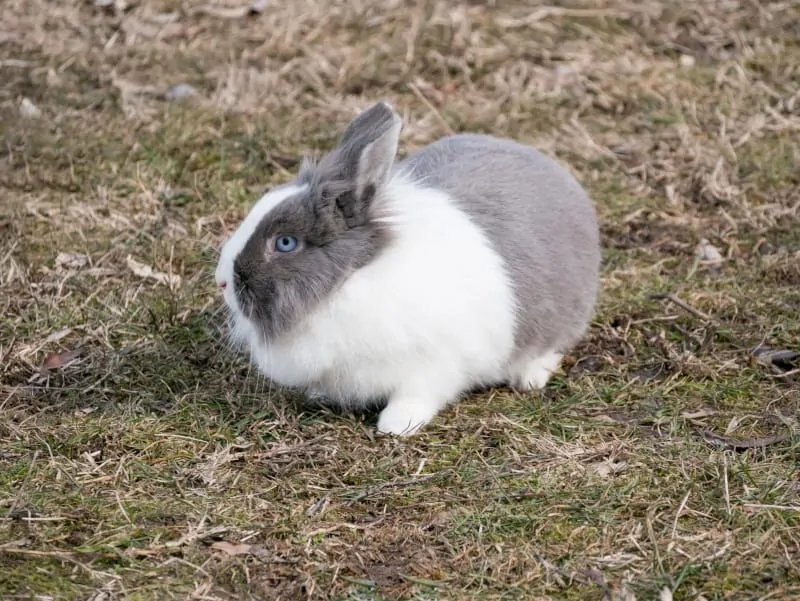One of the most important things we usually consider when choosing a bunny is the size of the animal. Smaller rabbits are especially popular because of their ease of handling and the small space they take up. Dwarf rabbits have their own personality and care needs. Here you will learn how to care for dwarf rabbits so you can keep them happy and healthy.
We want to begin by mentioning that the fact that it is a small rabbit does not mean that we have to offer them minimum care.
What is the Origin of Dwarf Rabbits?
The dwarf rabbit is also known as a toy rabbit. The first dwarf rabbits appeared in Holland in the 20th century. Their origin is due to the crossing between small rabbits, that resulted from the mutation of a recessive gene that causes dwarfism, with domestic and wild specimens. As a result of these crossings, dwarf bunnies, in particular, the Dutch variety, was able to establish itself.
Physical Characteristics of Dwarf Rabbits
Due to their small size, toy rabbits can be rather delicate and can be easily frightened. For this reason, they do not do as well with younger children, as some of the slightly larger breeds. Otherwise, they make excellent pet rabbits. Let’s take a look at some of their main characteristics:
- The dwarf rabbit average weight is between 1.7 pounds and 4 pounds, and measures between 30 and 50 centimeters.
- Unlike other rabbits that have long legs, these rabbits have thin, shorter extremities.
- Their ears are not too big, reaching an average of 5 to 8 centimeters long.
- Their heads are round, with a flat nose.
- They have a small neck, which gives the appearance of having their heads closer to the body than in other species, looking like a real hairball.
- The majority of these rabbits have short fur, although you may find some exceptions like the Lionheads.
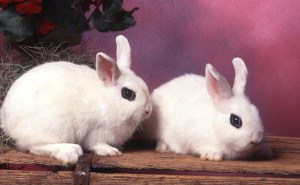
Overall, these rabbits are adorable, and their success is mainly due to their resemblance to a small cuddly toy.
How is Their Behavior?
Dwarf rabbits are quite smart. They are easy to train and can learn very quickly. Besides, these bunnies are very energetic and dynamic. They love to play and move around, so it would be perfect to have a large cage in case it is necessary to have them locked up. It is not a good idea to have them in a cage all the time as they can develop problems with their muscles and bones.
Being so tiny, these rabbits can be easily scared, but in most cases, they are pretty friendly and affectionate. Some breeds tend to nip more than others, so one must be careful with small children.
The dwarf rabbit is curious by nature and will make friends with everyone, even with other animals or pets which you have at home. However, these rabbits are usually very territorial, especially with other rabbits.
It is possible that at the beginning, your pet rabbit will look frightened and shy, as the new place is unfamiliar. It is necessary to be patient and let them discover their new environment. Little by little, they will become more confident and will feel much more comfortable.
Dwarf Rabbit Breeds
A useful way to classify rabbits is according to their size and weight. As the name implies, dwarf rabbits or toy rabbits belong to the smallest rabbit breeds. Small Rabbit Breeds usually reach a mature weight of fewer than four pounds. These are the breeds that belong to this category:
American Fuzzy Lop: (3 to 4 pounds)
These small rabbits characterize for having a big, flattened face with lopped ears. They look somewhat like a Holland Lop with Angora wool, and they come in a great variety of colors. If you love the Angora look and do not mind to spend a couple of hours grooming your pet, this breed is for you. Being a wool breed, it will require extensive daily grooming.
Britannia Petite: (2 to 2 12 pounds)
These tiny rabbits distinguish for having narrow heads and a trim, arched body line, and come in different colors, including white, black, agouti, chestnut, otter, and sable marten. Ears are medium long and erect. Experienced rabbit breeders have claimed these rabbits have a tendency to be more hyper and nip more often than other breeds, and that they require especially careful handling because of the delicate arched body type.
Dutch: (3.5 to 5.5 pounds)
These pet rabbits can be any of six different colors: black, blue, chocolate, gray or agouti, steel, and tortoise, but they always have a white blaze across the nose, a white band around the middle, and four white feet.
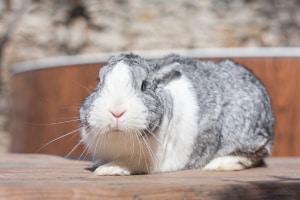
Dwarf Hotot: (2 to 3 pounds)
These small rabbits have a very peculiar appearance; they are all white except for a black ring around the eyes. They have compact, rounded bodies and short, upright ears.
Himalayan: (2 12 to 4 12 pounds)
These are pure white rabbits with ears, nose, feet, and tail colored black, blue, lilac, or chocolate. They have long cylindrical bodies with narrow heads and short erect ears.
Holland Lop: (2 34 to 4 pounds)
These rabbits have slightly flattened heads with small but solid bodies. They have lopped ears and a protruding crown. These amazing rabbits come in a large variety of colors and possess a soft, thin fur. Many people love the laid-back attitude of the Holland Lop.
Jersey Wooly: (2 34 to 3 12 pounds)
The Jersey Wooly has round and solid bodies. This bunny has short fur on the face and ears, in contrast with the rest of the body, which has a long, thick coat. They look like a Netherland Dwarf dressed in Angora wool. Also, they have rounded bodies and short, firm ears and are available in numerous colors. These rabbits require extra time for grooming and special diets.
Lionhead: (3 to 3 34 pounds)
They owe their name for the long mane of wooled fur around the neck and ears. Lionhead rabbits originated in Belgium but developed in England. The body is well-rounded with dense fur of medium length, but mane around the head can be two to three inches long.
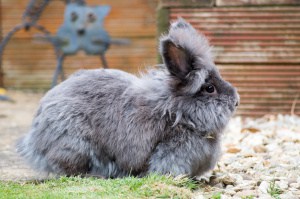
Lion-head rabbits can have lopped or upright ears. Both look equally adorable.
Mini Plush Lop: (2 12 to 3 12 pounds)
Devie D’Anniballe created this breed in the late 1990s, mixing the Mini Rex, with Mini Lop, and Holland Lop. The fur of a Mini Plush Lop is like that of a Rex rabbit, and its appearance lies between that of a small Mini Lop and Holland Lop. Personality is usually docile and affectionate.
Mini Rex: (2 34 to 4 12 pounds)
The Mini Rex is the small version of the Rex rabbit. The Mini Rex has a compact body with narrow shoulders, short, thick, upright ears, and a rex coat. Rex’s furs are famous for having a layer of outer guard hairs, which are thin, straight, and shorter than the undercoat, resulting in a plush coat that looks and feels like velvet. The Mini Rex is available in many different colors.
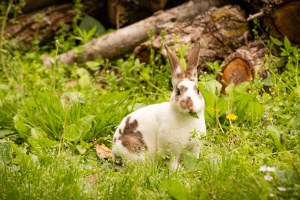
Mini Satin: (3 to 4 12 pounds)
They have beautiful shiny fur. They are available in eight different colors: black, chinchilla, chocolate, opal, otter, red, Siamese, and ruby-eyed-white. Other colors are under development.
Netherland Dwarf: (1 34 to 2 12 pounds)
These are the smallest and most popular breed among the dwarf category. These rabbits have small rounded bodies, large heads, short necks, and tiny, erect ears. The fur is glossy and dense and comes in many colors. Like the Britannia Petite, some rabbit owners claim these are more prone to nip than other rabbits and might be less suitable for children.
Polish: (2 to 3 12 pounds)
They possess a compact body and short, thick, upright ears. The fur is short and dense and comes in black, blue, chocolate, white, or broken, which is any color in splotches on white background.
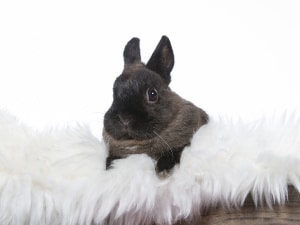
Toy Rabbits Main Cares
Amongst the primordial cares which we must offer to this type of rabbits are a balanced diet and an appropriate cage.
What do Dwarf Rabbits Eat?
Dwarf rabbits usually spend most of the day eating. This behavior is essential as rabbits require a continuous food intake to keep adequate intestinal motility. Their digestive system is too delicate. We need to keep an eye on the food we offer, as some meals can ferment in their digestive tract, producing diarrhea. Therefore, foods that are high in fiber and low in sugars, starch, and fats are more recommended.
It is necessary to offer a balanced diet to avoid our rabbits to gain a lot of weight. The amount of food we offer will depend on the stage of growth of our pet rabbit.
We must feed our baby rabbits with good quality hay. Hay should be available in the cage at all times. It is rich in fiber, so it helps regulate digestion and keeps the teeth that are appearing healthy. Commercial pellets can supplement the diet. Pellets should be rich in fiber and low in fat, recommended with a maximum of three tablespoons daily.
From the age of 3 months, we can add fresh vegetables to their diet. We should feed them small portions, that is, one or two different pieces of vegetables two days a week so that the rabbit can get used to their taste. We should remain alert in case they cause diarrhea or any discomfort. We have already talked in other posts about the best fruits and veggies for rabbits.
Fresh fruit should only be offered in limited quantities, from one to two times a week, because they are high in sugars and can ferment in their digestive tract, which can be harmful to the animal’s health. It is also essential to keep a fresh water supply throughout the day.
How Must Be Their Cage?
Despite being so small, they will need a roomy cage, as these rabbits are so energetic. The minimum requirement is 1 meter long and about 60 cm wide. It is not advisable to keep them locked up all the time as they can develop problems with their muscles and bones.
Inside the cage, you also have to put different accessories like a kennel where your pet can take shelter and feel safe. Also, it is advisable to set a small area around a corner where they can get used to doing their business.
We must keep their cage clean by removing the feces every day and doing a thorough cleaning every week. A place with poor hygiene is not acceptable, as our pet rabbit can get infections and get sick.
Final Recommendations
Rabbits are quite clean animals, so you won’t need to bathe them. They’ll take care of their grooming. In case they get too dirty, you can wipe them off with a damp cloth, but never bathe them because sudden changes in temperature can be fatal.
Finally, remember to take them to your vet for regular check-ups and keep their vaccinations up to date.
If you follow these tips, you will enjoy a happy companion for many years to come.

